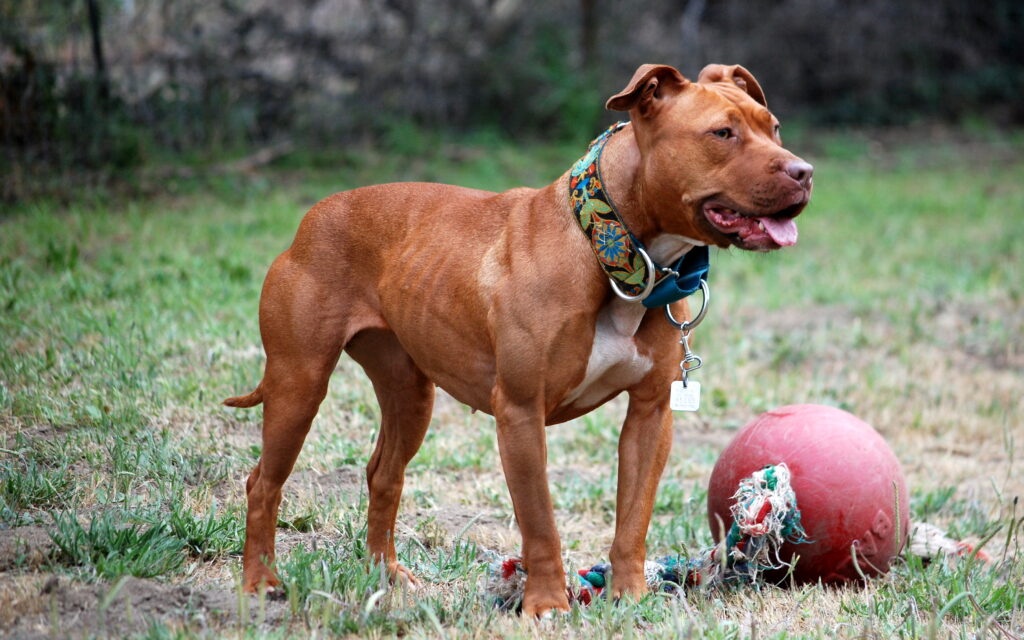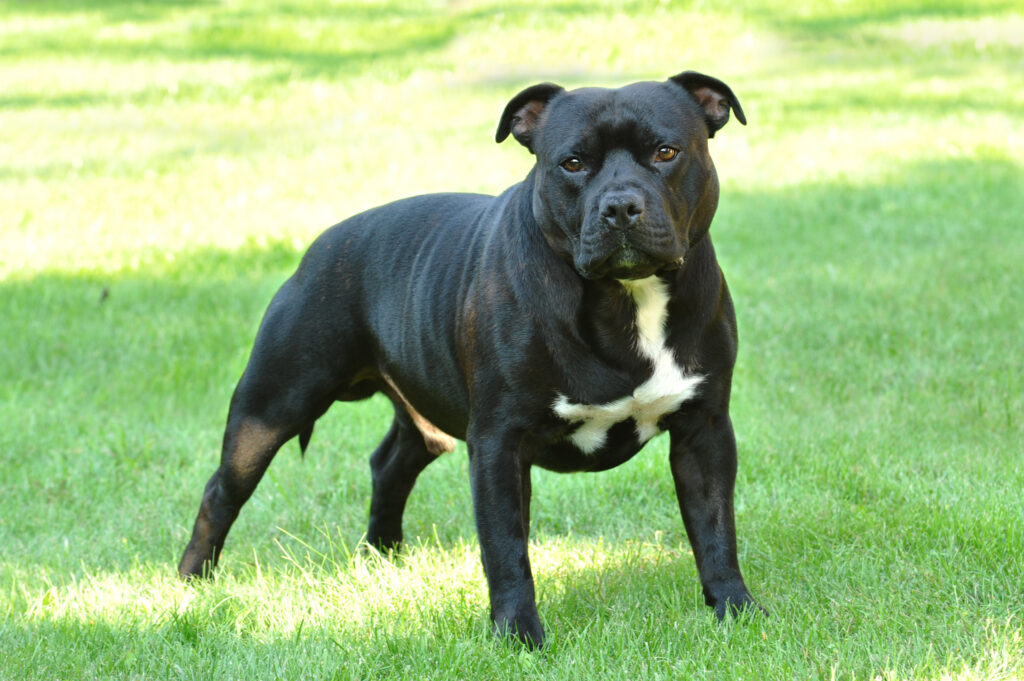Pit Bull dogs have long been a subject of fascination and controversy.
Known for their strength, loyalty, and sometimes misunderstood aggression, these breeds are often in the spotlight for both positive and negative reasons.
Despite the misconceptions, Pit Bulls can be loving, gentle, and loyal pets when properly trained and socialized.
This article delves into the top three different types of Pit Bull breeds: the American Pit Bull Terrier, the American Staffordshire Terrier, and the Staffordshire Bull Terrier.
Each breed has unique characteristics and qualities that set them apart, yet they all share the common Pit Bull heritage that makes them resilient, intelligent, and affectionate companions.
1. American Pit Bull Terrier

The American Pit Bull Terrier (APBT) is perhaps the most recognized and talked-about Pit Bull breed.
Known for their athletic build, strong jaw, and muscular physique, APBTs are often perceived as the quintessential Pit Bull.
History and Origin
The American Pit Bull Terrier’s history dates back to the 19th century in the United Kingdom, where it was initially bred from Old English Bulldogs and terriers.
These dogs were initially used for bull-baiting, a cruel sport that was eventually outlawed.
Once bull-baiting was banned, the breed transitioned into roles such as farm dogs and family companions.
Immigrants brought these versatile dogs to America, where they were further developed into the breed we know today.
Physical Characteristics
APBTs are medium-sized dogs, typically weighing between 30 to 60 pounds.
They have a short, smooth coat that comes in various colors, including brindle, fawn, black, and blue.
Their ears can be cropped or left natural, and their tails are long and tapered.
The breed is known for its muscular build, agility, and strength, making it a favorite among dog enthusiasts who appreciate an active and energetic companion.
Temperament and Behavior
Despite their fierce appearance, American Pit Bull Terriers are known for their friendly and affectionate nature.
They are highly intelligent and eager to please, which makes them relatively easy to train with positive reinforcement techniques.
APBTs are known to form strong bonds with their families and can be very protective.
However, they require early socialization to ensure they get along well with other pets and people.
Their high energy levels mean they need regular exercise to prevent boredom and destructive behaviors.
Common Misconceptions
APBTs often suffer from negative stereotypes due to their history and appearance.
Many people mistakenly believe that they are inherently aggressive and dangerous.
However, aggression is not a trait inherent to the breed; rather, it is often a result of poor training, neglect, or abuse.
With proper training, socialization, and care, American Pit Bull Terriers can be gentle, loving, and loyal pets.
2. American Staffordshire Terrier

The American Staffordshire Terrier (AmStaff) shares many similarities with the American Pit Bull Terrier but has distinct features and characteristics that set it apart.
Recognized by the American Kennel Club (AKC), the AmStaff is known for its courage, confidence, and friendly demeanor.
History and Origin
The American Staffordshire Terrier’s roots can be traced back to the same lineage as the American Pit Bull Terrier.
In the early 20th century, breeders in the United States sought to create a more refined and versatile dog, leading to the development of the AmStaff.
The breed was officially recognized by the AKC in 1936 under the name Staffordshire Terrier, later changed to American Staffordshire Terrier to distinguish it from the British Staffordshire Bull Terrier.
Physical Characteristics
AmStaffs are stocky, muscular dogs with a solid build.
They typically weigh between 40 to 70 pounds and stand about 17 to 19 inches tall at the shoulder.
Their coat is short, stiff, and comes in a variety of colors, including solid, parti-color, and patched.
The breed’s head is broad with a pronounced stop, and their ears are often cropped, although natural ears are also acceptable.
AmStaffs have a strong, athletic appearance that exudes power and agility.
Temperament and Behavior
American Staffordshire Terriers are known for their loyal, affectionate, and playful nature.
They are excellent family dogs and are particularly good with children due to their patience and gentle demeanor.
AmStaffs are highly intelligent and respond well to positive reinforcement training methods.
They thrive on human interaction and enjoy being part of family activities.
While they can be protective of their loved ones, they are generally friendly towards strangers when properly socialized.
Health and Care
Like all breeds, AmStaffs are prone to certain health issues, including hip dysplasia, allergies, and heart disease.
Regular veterinary check-ups, a balanced diet, and regular exercise are essential to keep them healthy.
Their short coat requires minimal grooming, but regular brushing will help keep their coat shiny and free of loose hair.
Due to their high energy levels, AmStaffs need plenty of physical and mental stimulation to prevent boredom and destructive behaviors.
3. Staffordshire Bull Terrier

The Staffordshire Bull Terrier, often referred to as the “Staffy,” is a smaller yet robust member of the Pit Bull family.
Known for their courage, tenacity, and affectionate nature, Staffies have a devoted following among dog enthusiasts.
History and Origin
The Staffordshire Bull Terrier’s origins date back to early 19th-century England, where they were developed by crossing Bulldogs with various terriers.
Bred initially for bull-baiting and later for dog fighting, these dogs were prized for their strength, agility, and determination.
With the decline of blood sports, the Staffordshire Bull Terrier transitioned into a companion animal, and their loving nature quickly endeared them to families.
Physical Characteristics
Staffordshire Bull Terriers are compact, muscular dogs, typically weighing between 24 to 38 pounds and standing about 14 to 16 inches tall at the shoulder.
They have a short, smooth coat that can come in a variety of colors, including brindle, black, blue, fawn, and red, with or without white markings.
Staffies have a broad head, pronounced cheek muscles, and a strong jaw, giving them a distinctive appearance. Despite their small size, they are incredibly strong and agile.
Temperament and Behavior
Staffies are known for their affectionate and friendly nature.
They are often referred to as “nanny dogs” due to their gentle and patient demeanor with children.
Staffordshire Bull Terriers are highly intelligent and eager to please, making them relatively easy to train with positive reinforcement techniques.
They are social dogs that thrive on human interaction and enjoy being involved in family activities.
Despite their history as fighting dogs, well-socialized Staffies are generally good with other dogs and pets.
Socialization and Training
Early socialization is crucial for Staffordshire Bull Terriers to ensure they develop into well-rounded adults.
Exposure to different people, places, and experiences helps them become more confident and less likely to develop behavioral issues.
Positive reinforcement training methods work best with Staffies, as they respond well to praise and rewards.
Consistent training and clear boundaries are essential to help them understand what is expected of them.
Other Stories You May Like
Conclusion
Pit Bull breeds, including the American Pit Bull Terrier, American Staffordshire Terrier, and Staffordshire Bull Terrier, are often misunderstood due to their history and appearance.
However, with proper training, socialization, and care, these dogs can be loving, loyal, and gentle companions.
Each breed has its unique characteristics and qualities, making them suitable for different types of families and lifestyles.
By understanding their history, temperament, and needs, potential owners can make informed decisions and help dispel the myths surrounding these remarkable dogs.






